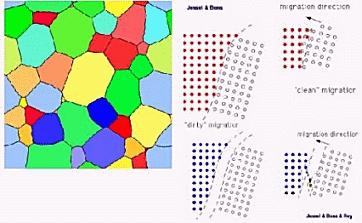GRAIN BOUNDARY MIGRATION
Grain boundary migration refers to the movement of the boundary separating two grains. The movement takes place by the diffusion of single atoms from one grain across the boundary to the other grain. This motion results in the migration of the boundary in the opposite direction to the diffusion direction. There are several driving forces for grain boundary migration, in decreasing order of magnitude they are chemical, strain energy (stored as dislocations), and elastic energy. The driving force for migration is the difference between, ffor example, the dislocation energy state either side of the boundary. The rate at which a boundary migrates is both a function of this driving force, and the mobility of the boundary, which is an inherent property of a material (but which varies according to temperature, the presence or absence of fluids, the nature of the boundary, and the impurity content of both the grains and the boundary). The grain bounaries are referred to as "Clean" which involves only local readjustment of grains as in case of isotropic rocks; or "Dirty" as in case of schistose rocks which may involves several minerals to be moved in place of just one or two. A clean boundary is therefore strictly an interface while dirty one a zone of finite width.

Jessel et al Monash Au